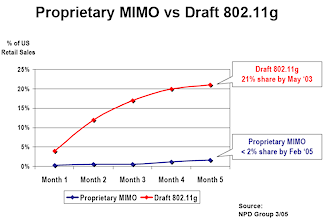Introduction
It’s the merry month of May again and in the networking world that means it’s time for the pilgrimage to the Las Vegas Convention Center for the Networld+Interop show. Except this year, the show has moved from the LVCC to the Mandalay Bay Convention Center and it’s no longer N+I, but just plain “Interop”. Whatevah…
Show management pegs the total estimated attendance at “over 17,500” (up from 16,000 in 2004) and the number of exhibitors at 375 (also up from 260 in 2004). But if the activity – or more accurately the extreme lack thereof – in the good ol’ press room is any indication, the show could be considerably less busy than expected.

No waiting at Monday registration
(photo courtesy of Interop)
But hey, let’s think positively and hope that Interop can manage to soldier on. After all, purveyors of enterprise networking equipment, won’t exactly fit in with the consumer networking crowd at CES!
Switching
In keeping with the enterprise focus of the show, networking gear makers D-Link, NETGEAR and Belkin are emphasing their “business” sides and that usually means switches. D-Link is returning to the show after a three-year absence and announcing four new switching products. The first item is the first fruit of its labors under Trapeze’s Open Access Point Initiative.
The D-Link DWS-1008 AirPremier Wireless Switch is an eight port Layer 2 10/100 switch that supports Trapeze Networks’ Mobility System Software (MSS) and can control up to twelve thin access points (APs), such as the Trapeze 300 series Mobility Point. The switch also supports 802.3af Power over Ethernet on all ports and is due out Q3 2005 at yet-to-be determined pricing.
D-Link is also announcing three additions to its xStack business-class switch line. The 10 GbE-capable D-Link xStack 3200 series switches include the 48-port Layer 2 Stackable Switch (DXS-3250), the 24-port Managed Stackable Switch (DXS-3227) and 24-port Managed Stackable Switch with 802.3af Power over Ethernet (DXS-3227P).
In addition to the usual VLAN, trunking, bandwidth-shaping and other normal managed switch features, the new 3200 series all feature “signature-based attack detection” and include built-in Access Control Lists and “IPV6 aware packet classification” – features normally found in firewalls instead of managed switches. D-Link also says the series will get wireless switch features via an optional firmware upgrade in Q4 of this year. The DXS-3250 ($3999.99) will be available in early July while the DXS-3227 ($2999.99) and DXS3227P ($4299.99) will be available in Q3 (MSRPs).
NETGEAR announced that it’s adding the ProSafe FS750T2 48 Port 10/100 Smart Switch with 2 Gigabit Ports ($550 MSRP, available now) and SNMP v1.0 support across its entire “Smart Switch” line. Current owners will be able to download a firmware upgrade to add SNMP this month. The FS750T2 features 48 10/100 Mbps ports, two copper 10/100/1000 Mbps uplinks and two hot-swappable Small Form-Factor Pluggable (SFP) GBIC slots for optional fiber connectivity.
Users with more modest port needs may instead go for the two VPN firewalls NETGEAR also introduced. The FVS124G ProSafe VPN Firewall 25 with 4 Gigabit LAN and Dual WAN Ports ($250, June) not only has four 10/100/1000 Ethernet LAN ports, but also sports dual 10/100 WAN connections. It supports up to 25 IPsec VPN tunnels and even includes a single user license of NETGEAR’s ProSafe VPN Client Software (VPN01L).
Take the same product, limit the number of tunnels to eight, take away a 10/100 WAN port and change the LAN ports to 10/100 and you have the FVS114 ProSafe VPN Firewall 8 with 4 Port 10/100 Mbps Switch ($97, June). To sweeten the pot a bit more, NETGEAR is bundling 60-day trials of Trend Micro’s Client/Server Suite for SMB and Client/Server/Messaging Suite for SMB with the new FVS124G and existing FVX538 8 Port 10/100 Switch, and FVS338 ProSafe VPN Firewall 50 with 8 Port 10/100 Switch and Dial Back-Up.
Also bringing switches to show, but not on the show floor, is SMC Networks. Their pre-show invite said they’d have a “new line of Smart switches” and be discussing plans for new enterprise wireless products.
But let’s say you already have plenty of switches, but are looking to add Power over Ethernet capability to support thin APs and IP phones. PoE “pioneer” PowerDsine will be showing its new line of Power over Gigabit Ethernet Midspans, including a 24-port model (6024G), which is in field trials now and expected to ship in July.
MGE UPS SYSTEMS and ADC will also be showing new midspans. ADC’s TrueNet Midspan PoE Controllers feature field upgradeable N+1 redundant powering and deliver up to 15.4 Watts of power per port. Up to five panels can be daisy-chained and controlled via one modular SNMP card and a single IP address. Pricing was not announced for either product.
Wireless
Most of the focus at Interop will continue to be on switched, thin-client wireless architectures and on adding intrusion detection features. Colubris last week announced that it will be integrating AirMagnet‘s wireless intrusion detection and performance management capabilities into its own wireless management system for shipment starting in Q3.
Aruba is taking an unusual approach to providing secure access to corporate networks with its new Personal Access Point. The $250 software product, which is available immediately, runs on any Aruba AP and lets users attach a “Personal AP” to any broadband connection. The Personal AP software then automatically builds a secure IPsec tunnel to a central Aruba mobility controller, authenticates, self-configures and begins operation. Personal AP uses NAT-T If the broadband connection is behind a firewall and employs “other mechanisms” if the user is connecting from a web-portal type connection such as those commonly found in hotels.
Network admins can remotely control parameters such as operating channel, radio type, SSID, BSSID and all associated clients, user security privileges, bandwidth per user, etc. Admins can also view detailed client status reports for remote office wireless, monitor usage levels, protect against malicious or unauthorized wireless use and perform packet capture for remote troubleshooting.
Cisco yesterday extended its “integrated services” router line downward with the introduction of three fixed-configuration routers. The Cisco 1800, 870 and 850 series all include embedded virtual private network (VPN) encryption and acceleration hardware supporting IPSec AES and 3DES encryption. Other features include stateful firewall, inline intrusion prevention, Network Admission Control (NAC) and URL filtering and support for MPLS-based VPNs.
The 1800 can also be equipped with dual-band 802.11a/b/g wireless while the 870 and 850 can be configured with a single-band 11b/g radio. All are available starting this month with suggested list pricing starting at $399 for the 850, $649 for the 870 and $1295 for the 1800 series.
One announcement that may have more of an impact on consumer wireless products is Atheros‘ decision to offer its JumpStart for Wireless automatic WLAN configuration software to the open source community free of charge. The company’s spin is that it is offering JumpStart for the good of the WLAN industry and to help customers avoid “getting locked into proprietary security systems that limit hardware choices”. Those proprietary security systems would probably include Buffalo Technology’s AOSS and Broadcom’s Secure EZ Setup. Once released, the JumpStart open source code, license and supporting materials will be available from SourceForge.
Speaking of major WLAN chipmakers, Broadcom appears to be keeping its head down and doesn’t plan any Interop announcements, especially about its MIMO plans. But in a “Wi-Fi market update” sent out last week, the company downplayed MIMO’s market significance.
The company pointed to recent retail sales numbers reported by the NPD Group that it said show that after 5 months of product shipments, the MIMO category represents only 1.6% of total Wi-Fi equipment sales (see figure below).
MIMO vs. Draft-11g adoption
The comparison presented in the graph isn’t even what one would call apples-to-kumquats, as it compares sales of products based on a draft standard that was mere months from ratification (draft 11g) with proprietary products using some pieces of technology that are hoping to be included in a spec that is over a year away (if that) from ratification and that doesn’t yet have even an approved draft spec.
What was conspicuously absent from Broadcom’s “update” was any mention of its own MIMO or 802.11n plans. Instead, it offered a rehash of the recently-failed 802.11n draft vote and only a statement that it is “deeply involved in the development of the 802.11n standard”.
And while Broadcom may be mum about its MIMO plans, (True) MIMO leader Airgo Wireless and partner Jungo Software Technologies announced the release of a “production-ready hardware and software reference design”. The design is intended for OEMs and ODMs developing MIMO-based residential and office gateways and adds Airgo’s hardware to Jungo’s list of platforms supported by its Linux-based OpenRG OS.

